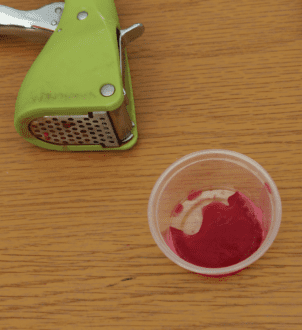

Oct 23, 2019Researcher’s quest for a red-juiced apple pays off
A trip to a Michigan State University (MSU) research field day this summer yielded a glimpse at an apple with rich red juice.
MSU Department of Horticulture Professor Steve van Nocker used a garlic press to crush a small apple. The resulting juice was dark enough that a thin splash was still ruby red.
The apple was part of a breeding line that he developed in recent years as part of the Michigan PureRed project.


“It won’t be of commercial value because the fruit is a little too small,” he said of the apple. “However, I showed you that to demonstrate the juice color – which is darker than any current red-juiced apple that we know of.”
Van Nocker spoke in late August at the Clarksville Research Station about his work to find cultivars bearing red-juiced apples. An international search identified more than 100 existing cultivars, which were whittled down to a subset of 10, and after a four-year period van Nocker and his colleagues had narrowed the search to three standouts: Otterson, Irene and Cranberry.
Then the group began its Michigan PureRed project by generating 17 breeding populations from the subset of 10 apple cultivars and some favorite mainstream commercial cultivars. The goal is to provide the state’s growers with reliable, profitable and versatile red-juiced varieties for commercial food processing uses including bottled juice products, ciders and natural colorants. While apple juice isn’t a glamorous venture for most apple growers, it could help supplement or diversify their farm operations.
“In years when fresh market production misses or prices are down, it provides some potential stability,” van Nocker said. “Growers generally don’t get excited talking about juice, since currently juice is made from fresh market fruit that don’t make the grade and prices are pretty low. Thinking about juice as a primary product will take getting used to.”
RELATED: Testing cider cultivars
A red juice apple cultivar is much different than a red-fleshed culinary apple, van Nocker said.
“I’ve had some pretty good red- fleshed fruit, but the flesh color wasn’t a dark red and wouldn’t be optimal for red juice. Also, I don’t believe consumers would be big fans of red-fleshed apples for more than a novelty,” he said. “The same compounds that contribute to the red color – anthocyanins – and their related compounds, probably make the fruit astringent.” Some of the genetic material used in red-fleshed culinary apples comes from ornamental crab apple trees.


The Michigan PureRed project has fewer than a dozen acres and less than 10,000 trees on five different sites around Michigan. Screening and selection have become more efficient since the gene primarily determining red flesh and juice has been identified.
While the new cultivars from the Michigan PureRed project are still in development, van Nocker said cuttings from the earlier project – the Otterson, Irene and Cranberry apple cultivars – are readily available.
“Growers can just ask and we can cut budwood from our MSU trees and ship it for a small fee,” he said. “These are also available from the USDA Plant Genetics Resources Unit in Geneva, New York.”
Otterson apples, which are about the size of tennis balls, have already been used for commercial production, and have been incorporated in hard ciders from two Michigan bottlers: Short’s Brewing in Bellaire and Left Foot Charley in Traverse City. Cider and juice from the red-juiced apples has won gold, silver and bronze awards at the Great Lakes International Cider and Perry competition.
“Otterson is the most vigorous and productive of the red-juiced cultivars, and doesn’t seem affected (so far) by the common apple diseases under minimalist management,” van Nocker said. “It’s grown very easily, and I think it might be great under organic regimes. In our planting at Clarksville this year, the yield for most trees was way down, and it probably is due to a very high yield last year. Of course, biennial bearing is not the best thing to see in an apple cultivar, so it might require some thinning. We’ll find out more about that this coming year.”
Red apple juice is high in anthocyanins and antioxidants, adding to its health benefits and marketability as an ingredient for food processing. “We haven’t had any communications with processors, but that might be premature as there is not so much fruit/ juice available yet,” van Nocker said. “The commercial products that we have used them in so far – hard ciders – seem to be successful, and cider makers are definitely interested.”
— Stephen Kloosterman, associate editor














